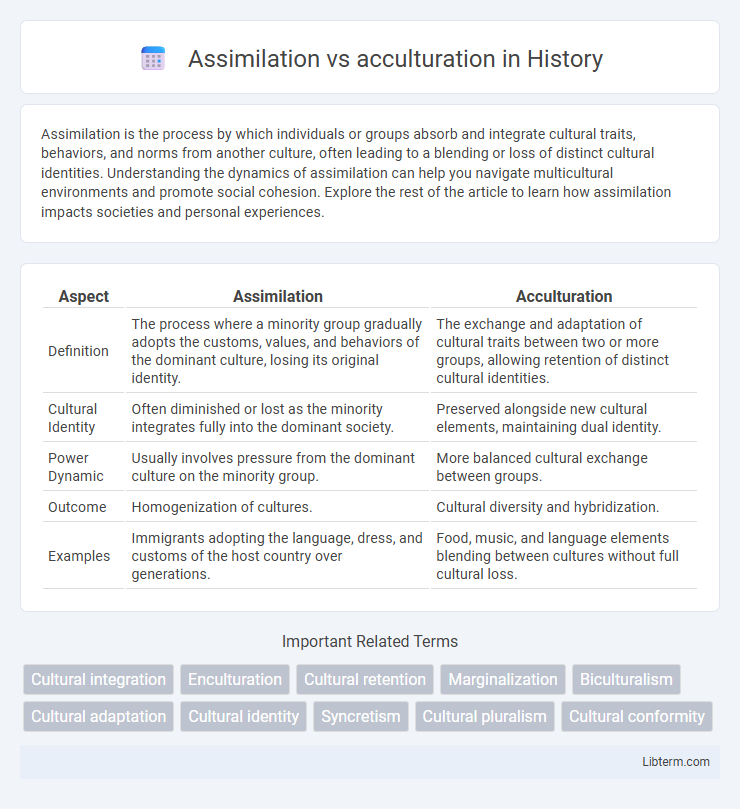Assimilation is the process by which individuals or groups absorb and integrate cultural traits, behaviors, and norms from another culture, often leading to a blending or loss of distinct cultural identities. Understanding the dynamics of assimilation can help you navigate multicultural environments and promote social cohesion. Explore the rest of the article to learn how assimilation impacts societies and personal experiences.
Table of Comparison
| Aspect | Assimilation | Acculturation |
|---|---|---|
| Definition | The process where a minority group gradually adopts the customs, values, and behaviors of the dominant culture, losing its original identity. | The exchange and adaptation of cultural traits between two or more groups, allowing retention of distinct cultural identities. |
| Cultural Identity | Often diminished or lost as the minority integrates fully into the dominant society. | Preserved alongside new cultural elements, maintaining dual identity. |
| Power Dynamic | Usually involves pressure from the dominant culture on the minority group. | More balanced cultural exchange between groups. |
| Outcome | Homogenization of cultures. | Cultural diversity and hybridization. |
| Examples | Immigrants adopting the language, dress, and customs of the host country over generations. | Food, music, and language elements blending between cultures without full cultural loss. |
Introduction to Assimilation and Acculturation
Assimilation involves the process by which individuals or groups adopt the cultural traits of another group, often resulting in the loss of original cultural identity. Acculturation refers to the exchange and adaptation of cultural elements between different groups while maintaining distinct cultural identities. Both concepts are central to understanding how immigrant populations and indigenous communities interact with dominant cultures in multicultural societies.
Defining Assimilation
Assimilation involves the process where individuals or groups fully adopt the cultural norms, values, and behaviors of a dominant or host society, often losing aspects of their original identity. It typically results in a blending where the minority culture becomes indistinguishable from the dominant culture. This concept contrasts with acculturation, which allows for cultural exchange while retaining distinct cultural identities.
Understanding Acculturation
Acculturation involves the process of cultural change and adaptation that occurs when individuals from different cultural backgrounds come into continuous firsthand contact, leading to changes in cultural patterns for both groups. Unlike assimilation, which implies complete absorption into the dominant culture, acculturation allows for the retention of original cultural identities while incorporating elements of the new culture. Understanding acculturation is essential in fields like social psychology, anthropology, and multicultural education, as it influences identity development, social integration, and intercultural communication.
Key Differences Between Assimilation and Acculturation
Assimilation involves one cultural group fully adopting the customs, language, and norms of another, often resulting in the loss of the original cultural identity. Acculturation refers to the process where individuals or groups adopt certain cultural traits or practices from another culture while retaining significant aspects of their original culture. Key differences include the extent of cultural change, with assimilation requiring complete integration, whereas acculturation allows for cultural blending and coexistence.
Historical Contexts of Assimilation and Acculturation
Historical contexts of assimilation often reflect policies where dominant groups impose cultural norms on marginalized populations, such as the U.S. Indian Boarding Schools aiming to erase Indigenous identities. Acculturation typically occurs through prolonged cultural contact and interaction, exemplified by immigrant communities blending traditions with host societies over generations. Both processes reveal complex power dynamics and varying degrees of voluntary adaptation or forced change throughout history.
Psychological Impacts on Individuals and Communities
Assimilation often leads to identity loss and increased stress among individuals as they abandon original cultural traits to conform to a dominant society, causing psychological distress and lower self-esteem. In contrast, acculturation allows for cultural exchange and adaptation, promoting psychological resilience and well-being by maintaining a balance between old and new cultural identities. Communities undergoing acculturation tend to experience enhanced social cohesion and reduced cultural conflicts compared to those pressured into assimilation.
Cultural Identity and Adaptation Processes
Assimilation involves the complete absorption of a minority group into the dominant culture, leading to the loss of original cultural identity, while acculturation allows for the retention of cultural distinctiveness alongside adaptation to the dominant society. Cultural identity in assimilation diminishes as individuals adopt new customs, language, and social norms, whereas in acculturation, individuals integrate elements from both cultures, maintaining cultural heritage. Adaptation processes in acculturation are dynamic and bidirectional, promoting multicultural coexistence, whereas assimilation emphasizes conformity and cultural uniformity.
Assimilation and Acculturation in Migration Studies
Assimilation in migration studies refers to the process by which immigrants adopt the cultural norms, values, and behaviors of the host society, often leading to the loss of their original cultural identity. Acculturation, by contrast, involves a bidirectional exchange where both immigrants and the host culture influence each other, allowing immigrants to maintain core elements of their heritage while adapting to the new environment. Research on assimilation highlights challenges such as social integration and identity erasure, while acculturation studies emphasize multicultural coexistence and hybrid cultural identities.
Real-World Examples and Case Studies
Assimilation involves minority groups fully adopting the dominant culture's norms, as seen in the early 20th-century European immigrant communities in the United States who largely embraced English language and American customs. Acculturation occurs when cultural exchange leads to adaptation without losing original cultural identity, exemplified by Mexican-American communities maintaining Spanish language and traditions while integrating into U.S. society. Case studies from multicultural cities like Toronto highlight acculturation's role in fostering cultural diversity and social cohesion without demanding complete cultural absorption.
Conclusion: Navigating Cultural Change
Assimilation involves adopting the dominant culture completely, often leading to the loss of original cultural identity, while acculturation allows for cultural exchange and retention of key cultural traits. Navigating cultural change effectively requires balancing integration with the preservation of heritage, fostering mutual respect and understanding. Successful multicultural societies implement policies that promote inclusivity, cultural diversity, and social cohesion to manage this dynamic process.
Assimilation Infographic

 libterm.com
libterm.com